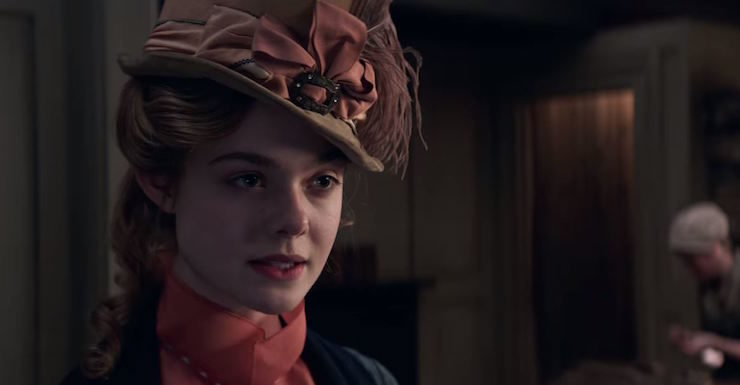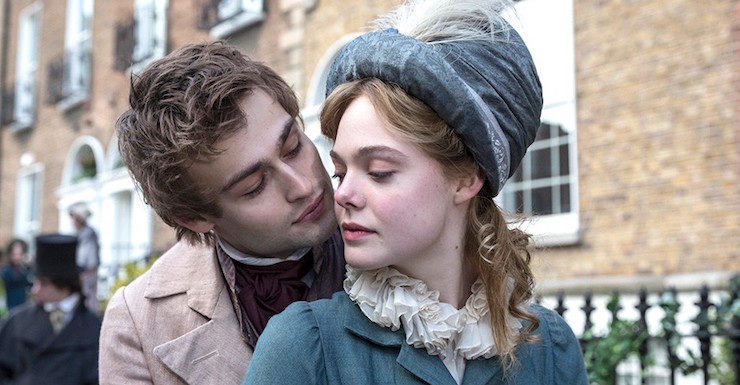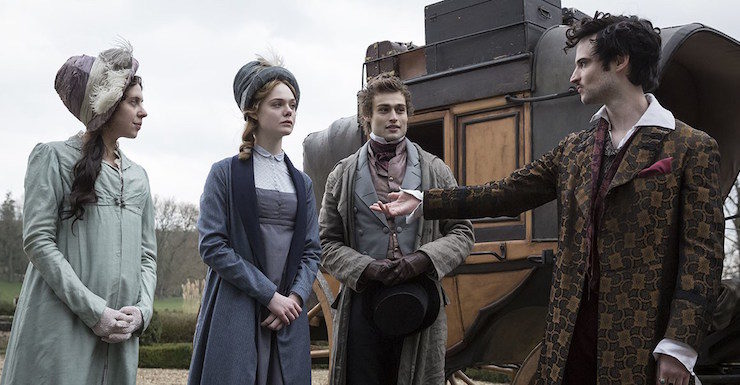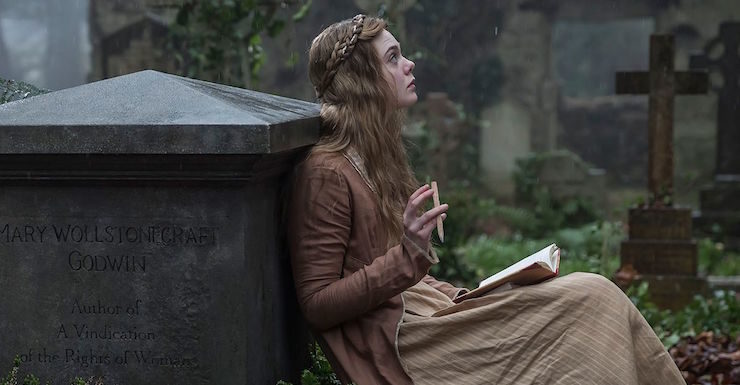I was introduced to the Romantic era of literature during my first year of college three decades ago when my Intro to Literature professor assigned not only the poetry of William Wordsworth but also the beautiful journals and letters of his sister Dorothy. That led to a fascination with late 18th and early 19th century literature that continues to this day, which was cemented by a two-semester Romantic Literature class that allowed me to immerse myself not only in the Wordsworths but also in William Blake, Samuel Taylor Coleridge, William Godwin, Mary Wollstonecraft, Thomas Hogg, Leigh Hunt, John Keats, Lord Byron, and, of course, Percy Bysshe Shelley and Mary Shelley. The latter three, in particular, fascinated me not just for their amazing writing, but also their tumultuous lives.
So I’ve been waiting thirty years for this damn movie.
Of course, Mary Shelley isn’t the first cinematic treatment of the lives of the Shelleys, Byron, Byron’s physician John Polidori, and Mary’s stepsister Clair Clairmont. They were first dramatized in the opening of The Bride of Frankenstein in 1935, where the characters were straight out of a drawing-room drama. The nonsense horror disaster Gothic, and the somnabulent dramas Rowing with the Wind and Haunted Summer also took shots at dramatizing this most amazing gathering. Plus, they’ve been seen in other places ranging from a particularly terrible episode of Highlander: The Series to the movie version of Brian Aldiss’s classic Frankenstein Unbound. All were inspired by the “lost summer” of 1816, described in Mary’s introduction to the 1831 edition of Frankenstein, when Byron proposed that they each write a ghost story. Mary’s entry became one of the most influential novels of modern times. (Polidori wrote a piece called The Vampyre, with its main character a thinly disguised version of Byron named Lord Ruthven, and was a major influence on Bram Stoker when he wrote Dracula.)
Previous versions almost always portrayed Mary as either a minor character, or as a stick-in-the-mud traditionalist who seemed uncomfortable and out of place with the freewheeling Percy and Byron. A lot of this is rooted in the way Mary was dismissed by academia up until the 1970s or so. Prior to that, she was considered a footnote to Percy’s brilliance—partly, to be fair, encouraged by Mary herself, as she spent a great deal of time after Percy’s death managing her late husband’s legacy and making sure he was well known as a great poet, often at the expense of managing her own legacy—and also to that of her parents, Wollstonecraft and Godwin, two of the towering intellects of the end of the 18th century. But two things changed in the latter part of the 20th century to remind everyone that she was pretty awesome, too: the rise of feminist scholarship (a lot of the dismissal of Mary was due entirely to her gender, a fate that has been suffered by many women writers) and the rise of popular-culture studies. Frankenstein was long considered unworthy of academic discussion, as it was a forerunner of science fiction and horror fiction, neither of which were fit subjects for literary criticism for quite some time.
At this point, though, she’s pretty well acknowledged as a major literary figure—but the portrayals of her by Elsa Lanchester, Natasha Richardson, Alice Krige, Lizzy McInnerny, Bridget Fonda, and Tracy Keating in the above-mentioned screen productions were all pretty lackluster.
Elle Fanning suffers from no such issues. Mary Shelley at last gives us the woman that we see in her writings and in the many biographies that have been written about her since the landmark Romance and Reality by the late great Emily W. Sunstein.

The very first thing we see Mary do in this movie is write. She’s sitting at the grave of her mother, scribbling down words. Wollstonecraft’s grave is her sanctuary—it’s where she and Percy later have their illicit meetings—as it’s the only place she can get away from her stifling home life. Wollstonecraft died in childbirth, and Godwin remarried to a woman with no intellectual curiosity, but who could help raise his children and also manage his business. Godwin and Wollstonecraft were radicals and believers in (among other things) free love. But as he aged, Godwin became more traditional. He condemned Mary and Percy for their relationship (Percy was still married with children at the time), despite Percy’s patronage helping to keep Godwin’s business from falling apart.
Fanning plays Mary with a passion for learning and for writing and for life that is a wonder to behold. She’s not always gripped with that passion—after the death of her daughter, Clara, she falls into a deep depression that she never completely comes out of—but it never goes entirely away, either.
What’s most impressive about Emma Jensen’s script is that it fully understands the themes of Frankenstein and how much of it was influenced by Mary’s own life. The primary theme of Frankenstein is not that science is bad, as many have insisted, but that one must claim responsibility for one’s actions, which do have consequences. The issue in the novel isn’t that Victor Frankenstein created a monster, it’s that he abandoned his creation, and that abandonment is what turned the creature into a monster. Mary spends the entire movie feeling abandoned: initially by her mother, who died in childbirth; by her father, who at once encourages her to read and write, yet stifles her ability to express her intelligence and her passion; routinely by Percy; by London society when she takes up with a married man. It’s no wonder her greatest work is about an abandoned creation turning evil.
The montage of scenes of Mary writing the novel (which includes flashbacks to other events in the movie as well as past instances of her writing) show the fervor with which she creates this germinal work. Every writer will recognize the compulsion in those scenes, the overriding need to get the words down, to get that particular story told.
Mary Shelley is all about actions having consequences, and how people deal with them, and it’s the title character who does the best job of doing so. Certainly her eventual husband doesn’t.

There are two things about this movie that are particularly admirable, beyond its excellent portrayal of its title character. One is that it is fully aware of the issues of class. None of the previous screen interpretations of this particular gaggle of creative types ever really dealt with that elephant in the room, focusing primarily on the scandals and the social interactions, but money was a huge part of everything that happened to the Shelleys. Godwin had to rein in his radical impulses because he had to make compromises for his children and his business. Percy’s position as a scion of a wealthy family put him in a position to be a radical (proposing such things as free love and atheism) without having to worry about consequences—at least until his father cut him off. (Running away from creditors was a constant theme in his life, and we see it a couple of times here.) Meanwhile, Byron can pretty much do as he pleases because he is a lord—his wealth gives him the freedom to behave as he will and to buy off consequences. And Clair simply wants to be away from the horrible lower-middle-class life she’s living, which is why she goes after Byron.
The other virtue of Jensen’s script is that she allows the characters nuance. It would be easy (and past portrayals have done this) to make Godwin simply a hypocritical old crank, to make Percy an idealistic buffoon, to make Mary a conservative voice amidst the radicals, to make Polidori a whiny little twerp, to make Clair a complete brat, and to make Byron a sleazy womanizer.
Jensen falls into none of these traps. (Well, okay, Mary Jane Clairmont, Mary’s stepmother, is still a one-dimensional shrew.) Polidori is a long-suffering physician trying and failing to manage Byron’s health. Percy actually is an idealistic buffoon, but at least he comes to realize it and try to make up for it, albeit in fits and starts—while you see why he and Mary argue, you also see why they fell in love in the first place. Godwin is still an old crank, but Stephen Dillane imbues Godwin with tremendous regret and sadness. Clair is something of a tragic figure here, a victim of her own expectations that she might mean something to Byron.
Tom Sturridge is particularly impressive as Byron, often a tough needle to thread. He was a complex figure—a cad, a sleaze, but also brilliant, with a tremendous sense of humor, a lack of patience with people who couldn’t keep up with him. All too often, the sleaze is the only part that comes through in fictional portrayals, but Sturridge shows us all of Bryon’s sides. His scenes with Mary show the respect he had for her intellect, despite his sexist instincts. (While it’s beyond the purview of this movie, which doesn’t go far past the initial publication of Frankenstein, Byron helped support Mary after Percy died, particularly when assistance from her disapproving father-in-law was slow in coming.)
The movie does play fast and loose with reality, and while many of those changes make the story flow better, they’re not all for the best. The biggest issue is that, according to Mary Shelley, the Shelleys spent most of their time in England, with the trip to Geneva where they hung out with Byron being only a few months. In fact, Mary and Percy spent most of their time on the continent after Godwin kicked them out. Frankenstein was written in Switzerland, not England, and the pair of them travelled all over Europe, not just to Geneva. (Mary’s first publication wasn’t Frankenstein, it was History of a Six Weeks’ Tour, a chronicle she wrote with Percy about their travels through Europe in 1814.) Also, Byron and Percy had a deep abiding friendship—they had nicknames for each other, Byron calling Percy “Shiloh” and Percy calling Byron “Albé”—which there’s almost no evidence of here.

Mary’s interest in science is seen, at least, although her reading of the works of Madam de Stäel and Erasmus Darwin is instead shown as her, Clair, and Percy attending a demonstration on galvanism. But other aspects of Mary’s life are removed: her other sister, Fanny Imlay (who committed suicide), and her other children who died young. I get why they compressed all of Mary’s lost children into Clara, but she did lose two other children, and the cumulative effect of that was an important inspiration for Frankenstein, as was Fanny’s suicide.
One change frustrates the Romantic literature geek in me, but it’s one of the best scenes in the movie. Shelley’s old college buddy Thomas Hogg comes on to Mary, assuming that she believes in free love as Percy does—and she does, in theory. But in practice, she only loves Percy. Percy doesn’t get this at all—his feeling is that free love means you should take every offer that comes, while Mary is more parsimonious with her love. Mary’s speech to him, and Percy’s thick-headed response is a great scene, a perfect encapsulation of the differences between them.
The problem is that it comes at the expense of Hogg, who comes across as a sexual predator. In fact, Hogg was one of Mary’s closest friends and a confidant of hers for years. It makes it hard for me to like the scene, as Hogg the historical figure deserves better than that.
The biggest change, though, practically threw me out of the narrative entirely. Mary is seen to be submitting her manuscript for Frankenstein, or the Modern Prometheus to multiple publishers, who all reject it due to its subject matter being inappropriate for a woman to write. This is revisionist hogwash, and not at all how the publishing industry worked in the early 19th century. Prose was considered a lesser form of writing, and in fact there were a lot more women novelists in that era precisely for that reason. No publisher would have had a problem with a woman writing a Gothic tale like Frankenstein. Also it wasn’t published anonymously to hide the fact that a woman wrote this great work, because that wasn’t an issue at the time. Neither was credit. It was later published with her own name, as seen in the movie, but that wasn’t due to her father’s efforts, but rather after a stage play was produced based on the novel.
The movie also ends with Frankenstein, but there’s so much more of Mary’s life to be seen. How did she deal with Percy’s death? Raising her one surviving son? The approbation given to her novel? The numerous stage plays based on it? Not to mention the ongoing financial issues, as she had to depend on the inconsistent support of her father-in-law and the money she made from writing. Instead, we get a diversion to Scotland that serves no plot function beyond an appearance by Maisie Williams (in a confidant role that’s already duplicated by Clair) and a cameo by Hugh O’Conor as Coleridge.
For people wanting to see a movie about one of the great figures of 19th century literature and the progenitor of science fiction, this is worth seeing. It’s not the gripping and telling biopic of Mary Shelley that she deserves, but it’s a definite improvement on what came before, and it’s certainly a step in the right direction.
I just hope I don’t have to wait thirty more years for the next one…
Keith R.A. DeCandido has been writing about pop culture for Tor.com since 2011. Currently his “4-Color to 35-Millimeter: The Great Superhero Movie Rewatch” appears on this site every Friday. When he isn’t rewatching superhero movies or geebling about 19th-century literature, he writes fiction, including more than 50 novels (his next two will be the original fantasy novels Mermaid Precinct and A Furnace Sealed), as well as short fiction (most recently “Six Red Dragons” in Baker Street Irregulars: The Game is Afoot) and comic books (he adapted Gregory A. Wilson’s Icarus into graphic novel form, and his “In Defense of Self” appeared in the Planned Parenthood benefit Mine!).











The filmmakers must not have done their research well, since they apparently did not take into consideration the success of Jane Austen–tho’ her name didn’t appear on any of her novels?*–or the woman novelists she satirizes in Northanger Abbey.
Have you read Ellen Moers’ Literary Women? Moers gives a great account of Shelley’s composition of Frankenstein.
*I don’t remember; I’m Victorian and wrote about Robert Browning’s The Ring and the Book and Charlotte Brontë’s novels in grad school :).
You don’t have to wait 30 years. A new TV mini-series about Mary has already been announced. :)
It’s going to be the third season of GENIUS, following seasons about Einstein and Picasso.
Gee, I can’t imagine why a father would object to his teenage daughter having a sexual affair with a married man. I can’t help noticing that free love was a lot better deal for men than it was for the women.
princessroxana: well when the father in question has written extensively and publicly and famously about how marriage is a stupid institution and in the belief of free love, it might justifiably be viewed as a skosh hypocritical…..
—Keith R.A. DeCandido
It’s a lot easier to be radical when you’re not the father of a vulnerable daughter.
@5/roxana: Mary was nearly 17 when she became involved with Shelley, who was only 22. By the standards of the time, it was acceptable for girls as young as 10 or 12 to get married, so nobody would’ve batted an eye at a 16- or 17-year-old girl seeing a 22-year-old man if he hadn’t already been married.
Back in 1997, I reviewed the Highlander: The Series episode “The Modern Prometheus” at length on HIGHLA-L, a mailing list for fans of the TV show. I just posted that review to my blog, for them that might be interested:
https://decandido.wordpress.com/2018/05/30/from-the-archives-the-modern-prometheus-episode-of-highlander-the-series/
—Keith R.A. DeCandido
You missed Frankenstein Unbound, that also had the Shellys and Byron. Oh and John Hurt and a time-traveling car.
https://www.imdb.com/title/tt0099612/
@7/krad: Your Highlander review mentions Byron’s illegitimate children making it unlikely that he was an immortal. Of course, I can’t resist pointing out that his one and only legitimate child was Ada Lovelace, the world’s first computer programmer. Lovelace was born 18 years after Mary Shelley and died 1 year after Mary did. I bet you could get a cool alternate-history story out of Mary and Ada teaming up to create a robot or fight crime or something. (There’s already a great, albeit inactive, webcomic about Lovelace and Charles Babbage fighting crime, although Babbage’s definition of crime is rather idiosyncratic.)
@6,Shelley turned out to be no prize. But there’s no talking to a girl in love.
@10/roxana: As Keith points out in his Highlander review, Mary was not some weak, naive, helpless child, but a strong-willed, intelligent young woman who’d already been through a lot in her life. People grew up a lot faster in those days, and she was smarter than most. I find it noteworthy that, in a famous literary contest against two older, accomplished writers, the “vulnerable teenage girl” was the only one whose creation became immortal and pioneered an entire new literary genre.
erwinschroedinger: I didn’t miss it, either, I mentioned it right there in the review with the other dramatizations of the Shelleys and Byron…..
—Keith R.A. DeCandido
@11, I meant Godwin saw her as vulnerable. Mary knew what she wanted and she kept on wanting Shelley for all his flaws and drawbacks. What can you do?
The fact is free love tends to turn out badly for women when the majority society doesn’t support it, and sometimes when it does. Granted it can go very wrong for men too but the social consequences tend to be less severe due to the double standard.
@princessroxanna When Godwin became involved with Mary Wollstencraft she had a daughter already from a previous love affair. It was only when she became pregnant that they decided to get married. So – while I agree there are different standards that men and women were held accountable for – I do think his sudden repudiation of his beliefs and his treatment of Mary when she became involved with Shelley is very hypocritical. Mary was very much schooled in reading all the works by both her parents – and others – and I think she was completely blindsided, and hurt, by his treatment of her.
That is probably true. Like I said it’s harder to be radical when it’s your child concerned, not yourself. Wolstencraft might have reacted much the same. Her own experience with Free Love hadn’t been all that grand until she reached Godwin.
I do not doubt that Mary was confused and stunned when Godwin turned conventional on her.
As I just learned on Facebook, thanks mostly to Greg Cox, the forthcoming first issue of the new Elvira, Mistress of the Dark comic book will have a very Elvira-ish version of the haunted summer as part of it. Writer David Avallone was kind enough to provide a preview illustration of Byron and the Shelleys:
As David said on Facebook, Mary was patterned after Elsa Lanchester in Bride of Frankenstein, while artist Dave Acosta appears to have made Percy and Byron look like Bill & Ted and now I’M TOTALLY ON BOARD FOR THE FANFIC WHERE BILL & TED ARE SHELLEY & BYRON NOW PLEASE!!!!!
*ahem*
—Keith R.A. DeCandido
@9/ChristopherLBennett. Fortunately Padua’s Lovelace and Babbage has been made into a book — an alternate history graphic novel. It is a treasure and delightfully funny — as well as “Eisner Awards Nominee! Over 6 months on the New York Times Bestseller list! Winner of the British Society for the History of Mathematics Neumann Prize, the British Book Design Award, and finalist for Goodreads Best Graphic Novel!”
I may need to go read it again right now. I must admit, it occupies a special place in my heart, given that I’m a female with a 1970s BS in Computer science (and a longtime fan of the Regency Romance).
@17/nancymcc: Given that Sydney Padua is an animator working for Pixar, I keep wishing for a Pixar-made Lovelace and Babbage feature film. But I suppose that’s unlikely.